Part 8: Episode 08: The Dead Speak
This update covers:Naomi Kimishima 2 - Locked-Room Mystery(part 3 of 3)
In the previous part, we established one important fact: that Dennis Taylor was murdered for his drugs that he had because he deals drugs. Drugs. We still don't know how the murder happened, but we do know there was a loud noise and a fire at 3, and that the last time he was seen alive was at noon. The shirt the body was wearing is different from the one he was wearing earlier that day. Also, the amount of blood found in the room is a fair amount lower than what would normally be required to bleed out. Today, all the questions will be answered.
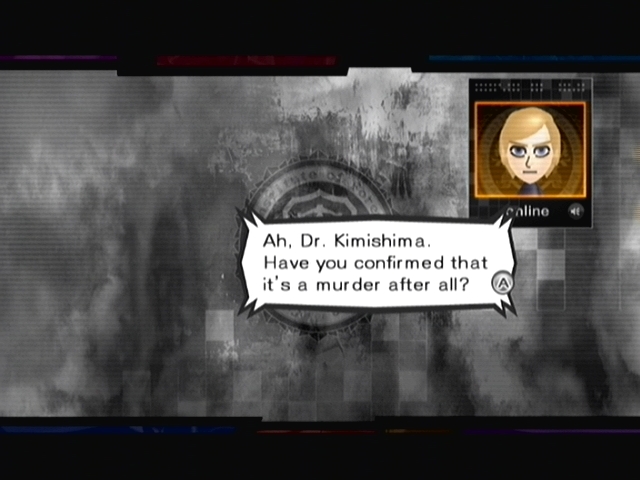
Naomi: I don't know how you heard about that so quickly, Little Guy. Have you been eavesdropping on me?
LG: Huh? N-no, I-
Naomi: Ha… Forget it. I can see right through you.
LG: Ahaha… Uh, oh right! I have a new tool for you. It's luminal. Do I need to explain it to you?
Naomi: A chemiluminescent material based on reducing 5-nitrophthalhydrazide with sodium dithionite. It reacts to iron in haemoglobin by glowing, making it useful to find otherwise hidden bloodstains. Anything else?
LG: Um… no.
You've seen this in any CSI show or game or whatever, I'm sure. Basically you spray it and shine the ALS on it. We can now head back to the crime scene with it, and see what we find.
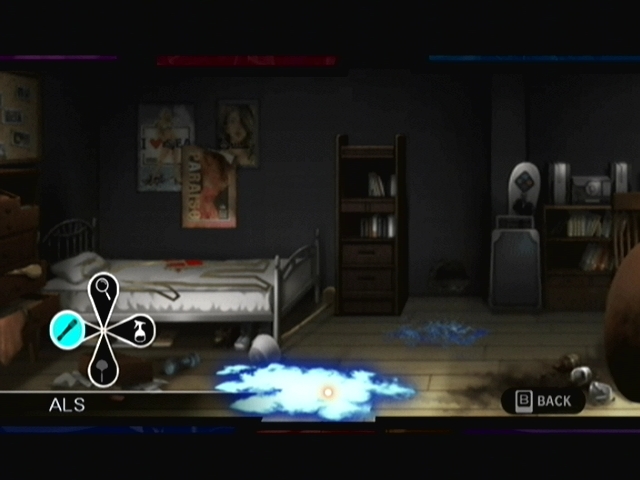
Naomi: So there were bloodstains here, too.
The other two are harder to find. I got stuck here for some time, not knowing what to do.
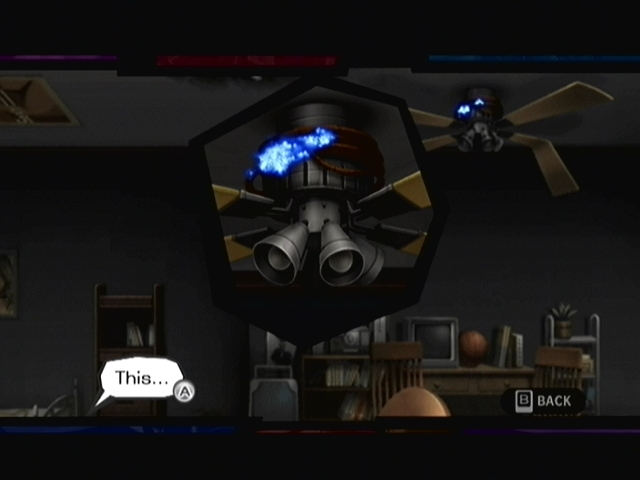
Naomi: There's a rope wrapped around the shaft of the ceiling fan? There's no mistake; those are bloodstains.
That's a little weird. This one was actually easy to find because it was in some of the trailers for the game. It's the last one that threw me.
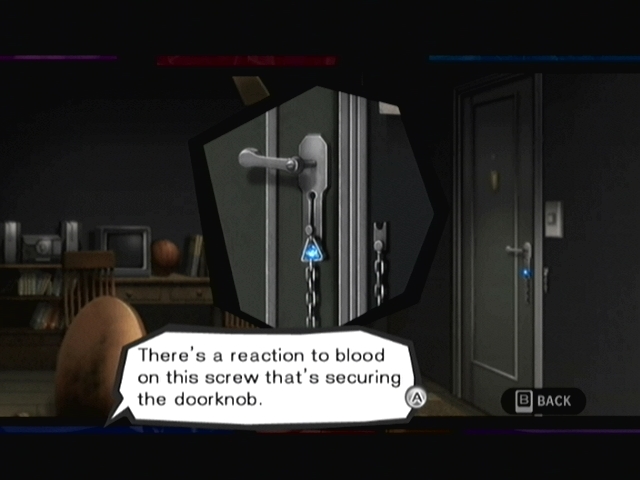
Naomi: The screw seems rather loose, as well. Come to think of it, the door to this room was chained shut when the fire started. Could this be related?
We're done here, now, and we won't be coming back. Starting to figure it out, yet? Well, there are a few tests that have to come back before we can see the whole picture.
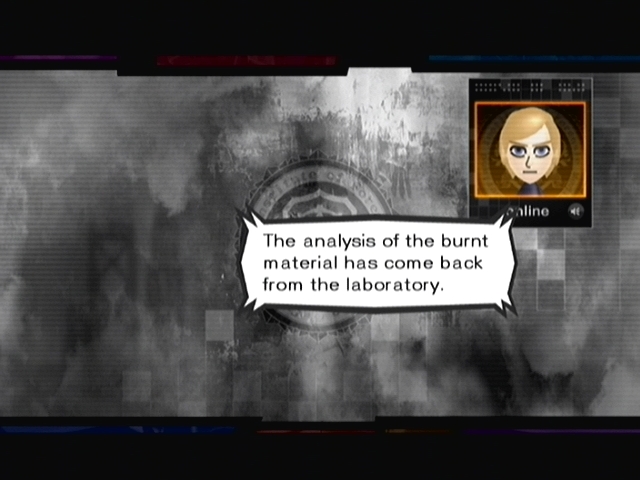
LG: Calcium hydroxide was detected in the sample. Small amounts of quicklime were also detected. Quicklime is a substance that releases a great deal of heat when it reacts with water.
Naomi: So, this was used to start the fire.
LG: I agree, but isn't it odd? There are much easier ways to start a fire.
Naomi: You're right. We'll have to investigate this.
With no particular order in mind, how about we next have the blood on the screw examined?
LG: It's a DNA match with the victim. Why would his blood be there?
Naomi: It's simple.
LG: Why would the killer touch a screw with the muder weapon.
Naomi: He would have to, if the weapon was a screwdriver. It was likely used to both loosen and tighten that screw. That left blood on the screw.
On that note, let's have the screw looked at.
LG: It just looks like a loose screw to me.
Naomi: Think harder, Little Guy. How was the room when the firefighters arrives on the scene? It was closed, but locked only with a chain. The door itself wasn't locked. The killer was able to get through by
LG: I see now. That's more than enough room to get past the door. So the killer just screwed the plate back on from the outside when he left, then?
Naomi: I think that's the most likely explanation. The killer was in plain sight outside the door. He wanted to finish quickly. He couldn't completely tighten the screw, and left the area as we found it.
LG: This proves that this isn't quite the locked-room mystery we thought it was.
This gives us the "locked-room trick" golden evidence card. Now, let's compare the large bloodstain we found in the room with the one on the bed.
Naomi: Now… which of these happened first?
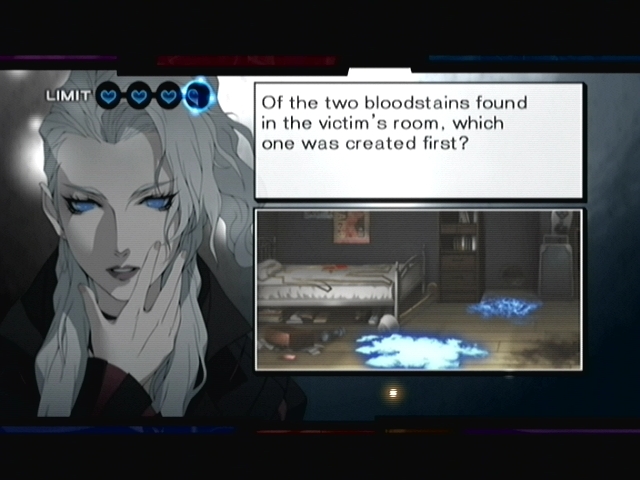
Questions of this nature are rare, but require you to point at the right part of the picture. It's a lot like Phoenix Wright. In this case, the answer is the large, hidden stain. Unlikely that the corpse would have gotten up and walked around on its own.
Naomi: It's most likely that the deceased died were the first bloodstains were found, and was carried to the bed afterwards. That would explain why there was such a small amount of blood on the bed itself.
Let's go back to that screwdriver for a moment. If you remember, there was an odd flower-shaped mark on the deceased. Maybe it didn't remind you of anything at the time, but it light of the real murder weapon, it becomes more interesting.
Naomi: I didn't notice because the bleeding had stopped completely, but this isn't a bruise. It's a stab wound. This strange pattern is likely a screwdriver's handle. The weapon was jammed in so deeply that the grip left a bruise.
Let's take it a little further and combine this new information with the blood spots we found in the eyes.
Naomi: Looking at the location of the bruise. The tip of the screwdriver must have pierced Dennis' lung. The lung would then rupture, causing pulmonary emphysema, and he would have suffocated. This explains the spots of haemorrhaging in the corpse's eyes.
One more step to this: now that we know the true cause of death, combine it with the evidence that the corpse was moved.
Naomi: These two can tell us how the murder happened. On the day of the incident, the killer came to the victim's room and stabbed him in the torso with the screwdriver, causing death by asphyxiation. Then, they moved the body in order to make it look like a suicide. This is what I believe took place, according to the evidence we have gathered.
That's one more golden evidence card, the "murder timeline." The next one is a short one. We'll compare two accounts of the deceased's behavior: one from his ex, and the other from the electrician.
Naomi: There's something very wrong about this. The two accounts differ dramatically on Dennis' behavior. On one hand, drug-dealing scum, enjoying his life. On the other, a man with suicidal depression? They don't seem to refer to the same person at all. Either one of these clues is false, or there's more to this shady business that I haven't found out.
This gives us a golden card called "Dennis the Pusher." Next, we have to approach the matter of the fire. First, we have to investigate the fan by combing the bloody rope with the broken fan.
Naomi: That rope coiled around the ceiling fan is what caused it to break. The question is: Why was it there in the first place?
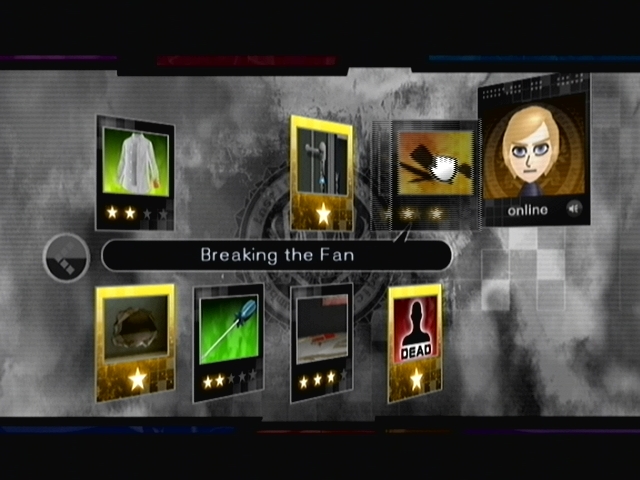
Now, combine the broken fan with the burnt chemicals.
Naomi: The fire began near the fallen table. Calcium hydroxide was found in the substance on the floor there. Calcium hydroxide is formed through the reaction of quicklime and water. This reaction also creates heat. Quicklime releases 65 kilojoules of energy per mole when it reacts with water. This was the method used to start the fire. First, you would place a glass of water on the table. You would also put quicklime around the floor and on the table near the glass. When the table falls over, the hydration heat from the reaction would cause a fire. Why would the killer go through so much trouble to start the fire?
That's one more gold card. There are only a handful of cards left, now. You'll only get this if you back out, but Naomi will remark that something doesn't fit with the true cause of death. For this, you need to check the victim's effects one more time. Something is missing.

Naomi: The one thing that should be on the clothing in the same place is…
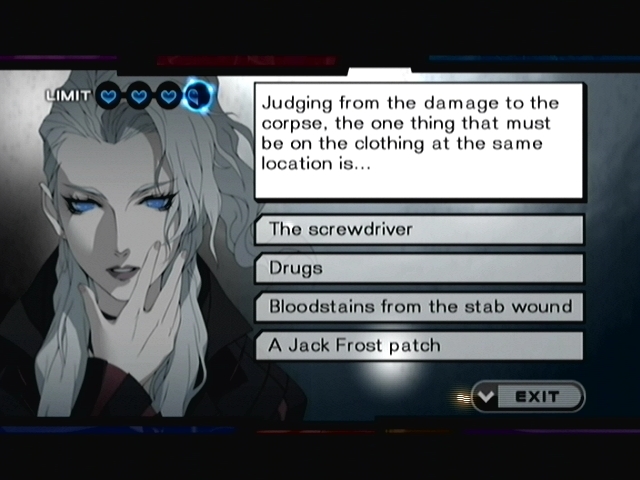
I've never played SMT but a Jack Frost patch would be pretty cool.
Naomi: …bloodstains and a hole from the stab wound.
Back at the office, this can be combined with the card indicating the clothes were changed.
Naomi: According to his friend, Dennis had been wearing a red T-shirt on the day of the incident. When Dennis's body was found, it was wearing a white shirt.[/I] In other words, his clothing had changed. If that was all we knew, we couldn't rule out that the deceased had changed it himself. However, if he did, there would still be a discrepancy. The white shirt doesn't fit the facts because it has no indication of a stab wound. There's only one answer to this puzzle: the killer changed Dennis after killing him. The reason for this was to make it look like a suicide by leading us to believe that a slashed wrist was the cause of death.
Combine this with the broken finger, which has been sitting uselessly in our PC for some time.
Naomi: There are no vital reactions in the broken finger, which means the break occurred after death. Considering that the killer must have changed the victim's clothes after death, it is likely that the finger was broken while changing.
That's the last card we had. Now we have nothing but gold cards and the victim's last words.
LG: Dr. Kimishima, how's the investigation going?
Naomi: I've uncovered the deception, but the truth hasn't completely been revealed. I need conclusive evidence to help us identify the killer.
LG: The most reliable givaway is if we could find a fingerprint at the crime scene. However, only the victim's fingerprints were found when HQ searched the room.
Naomi: I'm not surprised, considering the lengths the killer went to hide his tracks. He was probably wearing gloves.
LG: Is there anything the killer might have touched that would require him to take his gloves off? The best evidence would be on a hard, slick, inorganic substance. It doesn't matter what size it is.
This is a fun puzzle, since that's the only hint you get from the game. We know of plenty of things that the killer would have touched, but they were all in the crime scene, which has already been printed.

Naomi: The killer would have had to button up the shirt, as well. That would be extremely difficult with gloves on. If my predictions are correct…
Analyse this, and you're done.
LG: A button on the shirt, huh? I'll look into it right away. One moment, please! …It's there! I found it! There's a fingerprint from someone who isn't the victim. It's a… right thumb!
Naomi: Run it through the list of registered offenders immediately.
LG: Such an attention to detail has gone into this. It can't possibly be a first time offender. There has to be a match in our database.
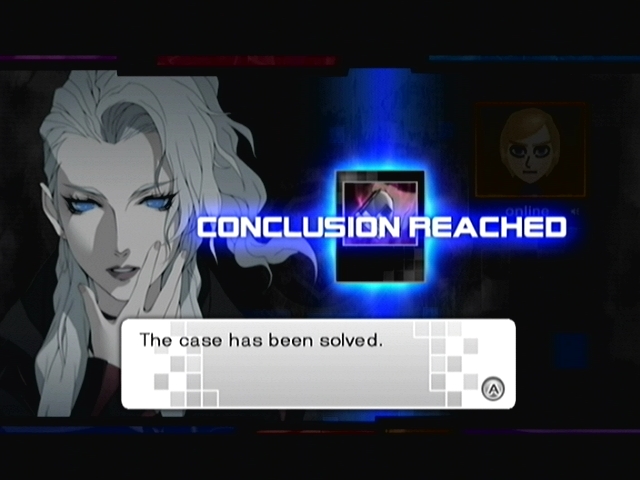
Locked-Room Mystery: Ending (Watch this shit!!!)
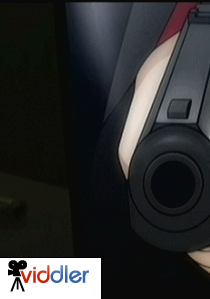

Next time: Hank meets a recycled plot point. And then back to Naomi. The adventure stuff is really front-loaded into the plot, sadly. It does horrible things for the pacing.
Medal Challenge Answers
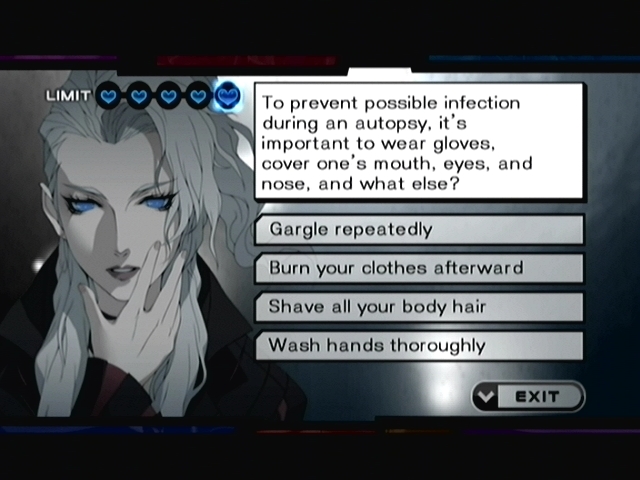
Answer: D
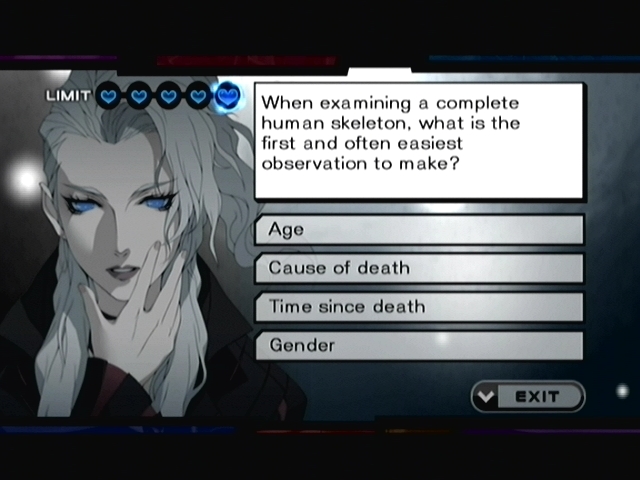
Answer: D
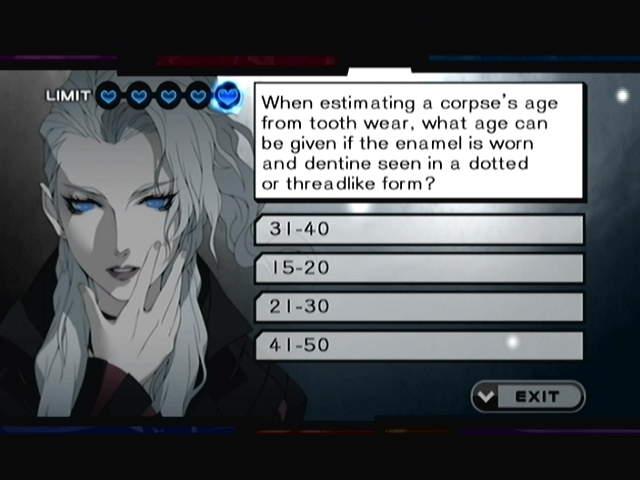
Answer: A
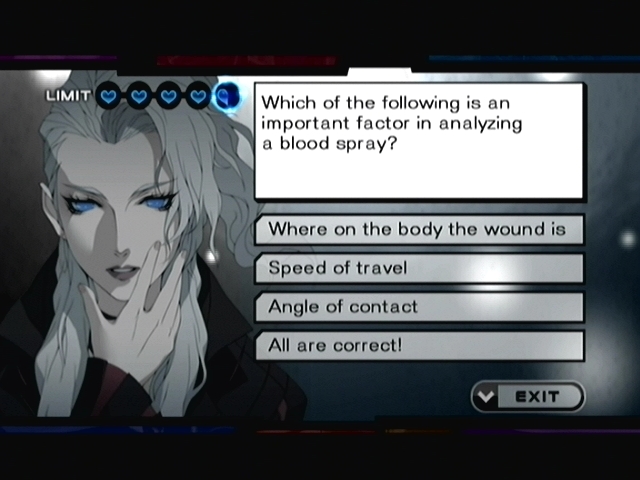
Answer: D
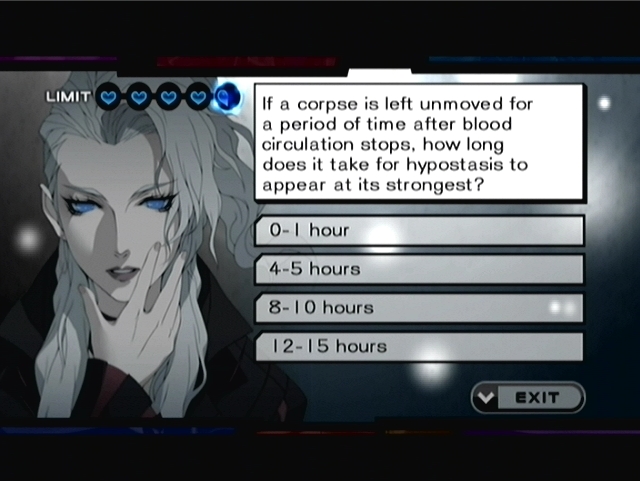
Answer: D
These are the answers given by the game. You may have reason to disagree with them. The last one, in particular, seems to have a bit of wiggle room. Nobody got all of them, but there were some valiant efforts.